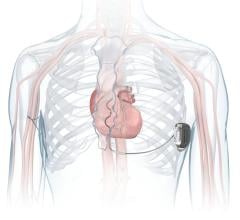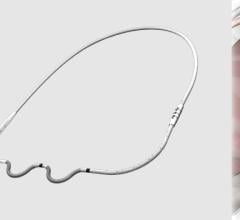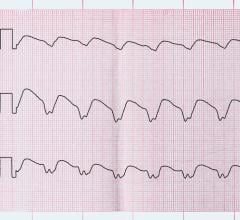June 14, 2016 — Medtronic plc announced results from several feasibility studies evaluating a new approach to implantable cardioverter defibrillator (ICD) therapy at Cardiostim/EHRA Europace 2016, the World Congress in Electrophysiology and Cardiac Techniques, in Nice, France.
The Medtronic EV-ICD System, which currently is in development and not available for use or sale, is a new approach to ICD therapy, with leads placed outside the heart and veins, and under the rib cage. The studies presented are the first to evaluate the new concept, and the results demonstrate that "extravascular" lead placement may provide the same benefits achieved with conventional ICDs, including pacing the heart in patients at risk of dangerous heart rhythms.
"Physicians are interested in an ICD with a similar device footprint and performance profile of conventional ICDs — but without the need for vascular access — and these study results are encouraging," said Francis Murgatroyd, M.D., consulting cardiologist and director of cardiac electrophysiology at King's College Hospital in London. "We look forward to further assessing the benefits of the EV-ICD approach in order to make this important advancement a reality for physicians and patients worldwide."
The Medtronic EV-ICD system in development consists of an implanted device, a newly designed lead and procedure tools to guide the efficient delivery of the system. Like conventional ICDs, the system is designed to deliver life-saving electrical shocks to protect patients from sudden cardiac death; to deliver anti-tachycardia pacing (ATP) to pace the heart out of potentially life-threatening heart rhythms that can lead to sudden cardiac death; and to provide post-shock pacing. Similar to transvenous ICD systems, the Medtronic EV-ICD is projected to have longevity of approximately 10 years and an expected device volume of approximately 33 cc. In addition to these potential benefits, the EV-ICD approach is designed to prevent the rare but potentially serious risks that can occur when leads are implanted inside the vasculature and the heart.
The data presented at Cardiostim 2016 assessed the feasibility of pacing and defibrillation with leads outside the heart and under the rib cage:
- Substernal Pacing Acute Clinical Evaluation (SPACE) studied 26 patients from eight sites in the United States and Canada, with preliminary data demonstrating that pacing is possible from a lead placed outside the heart and under the rib cage (also referred to as extravascular space), with the majority of patients achieving consistent and appropriate ventricular pacing results;
- Results from a prospective, nonrandomized study of 16 patients scheduled to undergo a midline sternotomy and implant of an ICD demonstrated that defibrillation is possible with the lead placed under the rib cage, and energy levels that are consistent with conventional ICDs;
- Anatomical analysis of computed tomography (CT) scans from 68 patients with cardiovascular disease found that, despite considerable variations in patient anatomy, placement of a lead between the rib cage and heart should be feasible with limited interactions with the lungs; and
- A final abstract demonstrated that the EV-ICD approach requires lower energy (defibrillation thresholds) than subcutaneous devices, and comparable energy to conventional ICDs.
Sudden cardiac arrest is an abrupt loss of heart function that can result in death if not treated within minutes. Conventional ICDs involve leads (thin wires) connected to the heart to deliver shocks or ATP that restore normal heart rhythms. ICDs are proven to be 98 percent effective in treating dangerous ventricular arrhythmias that can lead to sudden cardiac arrest.
For more information: www.medtronic.com


 February 12, 2024
February 12, 2024 








